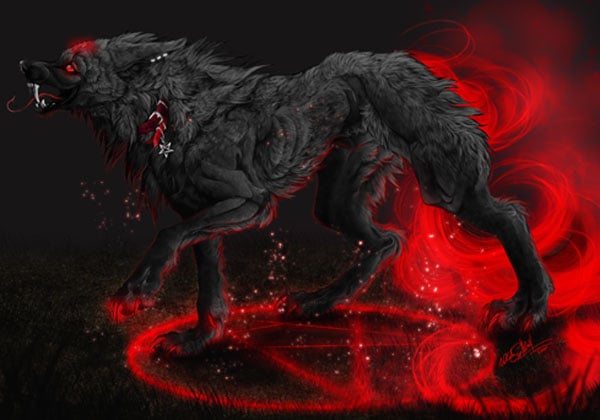Do canine remains belong to the legendary Hell Hound of Suffolk?
Archaeologists discovered the skeleton of a massive dog that would have stood 7 feet tall on its hind legs, in the ruins of Leiston Abbey in Suffolk, England, according to a report in The Express. The remains are near where an ancient legend spoke of a hellhound called Black Shuck, said to have flaming red eyes and a rugged black coat, who terrorized villagers.
The name Shuck derives from the Old English word scucca meaning ‘demon’. He is one of many ghostly black dogs recorded across the British Isles. Its alleged appearance during a storm on 4 th August, 1577 at the Holy Trinity Church, Blythburgh, is a particularly famous account of the beast, in which legend says that thunder caused the doors of the church to burst open and the snarling dog crashed in and ran through the congregation, killing a man and a boy, before it fled when the steeple collapsed. The encounter on the same day at St Mary's Church, Bungay was described in ‘A Straunge and Terrible Wunder’ by the Reverend Abraham Fleming in 1577:
This black dog, or the devil in such a likeness (God he knoweth all who worketh all,) running all along down the body of the church with great swiftness, and incredible haste, among the people, in a visible form and shape, passed between two persons, as they were kneeling upon their knees, and occupied in prayer as it seemed, wrung the necks of them both at one instant clean backward, in so much that even at a moment where they kneeled, they strangely died.
Brendon Wilkins, projects director of archaeological group Dig Ventures, said: “Most of these legends about dogs may have some roots in reality.”
The remains of the massive dog, which is estimated to have weighed 200 pounds, were found just a few miles from the two churches where Black Shuck killed the worshippers. It appears to have been buried in a shallow grave at precisely the same time as Shuck is said to have been on the loose, primarily around Suffolk and the East Anglia region.

The remains of the huge dog found in Leiston Abbey, Suffolk. Photo credit: East Anglia News Service
Radio carbon dating tests will be carried out to give an exact age for the bones, which will either serve to enhance the hell hound stories, or support the far less exciting theory that it is an abbot’s old hunting dog. Regardless of the outcome, it is unlikely to change the iconography of the local area, which relies on stories of Black Shuck to attract curious visitors.
Featured image: Harakiri: demonic hellhound. Image credit: WhiteSpiritWolf

















Comments
I thought of a wolfhound too. They were in great demand internationally.
They are massive.when I was about five we went up to Donegal and the place where we stayedd had wolfhounds. i was allowed to ride on its back. They look terrifying because of their size but they actually have a wonderful temperament.
They can also be a very dark grey, almost black, which how how the name might have come about.
HA! This is where im from! :D :D
Interesting to know is that there are massive claw marks going down the church door from when the dog attacked.
The most popular "tale" is that he was aboard a ship of the coast (its super close) when they got shipwrecked. Shuck managed to get onto a rock outcrop with his owner but he was the only one to survive. Then because he wouldnt leave the rock, even after the storm had passed, he starved to death.
After this it gets a bit murky as to why he came back as a demon dog, but the beggining is mostly the same.
The Darkness - Black Shuck
https://www.youtube.com/watch?feature=player_embedded&v=jeRY-jxKuqA
These guys are from round the corner ^^
There could have been ritual reasons for the burial, or maybe the corpse was already dead when i was found.
That the grave was shallow implies to me that it may not have been necessarily had an owner because a shallow grave would make it more likely that predators (if there were any in the region) and carrion feeders would discover it.
I would think that one prepares a shallow grave because there's lack of connection to the dead, not more.
If it "appears to have been buried", it must have had an owner. Maybe this is just one of them local big dogs.
I thought it was pretty awesome
Pages